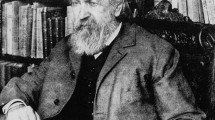Abstract
The adjective ‘scientific’ as used in the title of this lecture refers in the first place to modern experimental and mathematical physics; and to the other natural sciences insofar as they follow the lead of physics and thrive in its light. I do not place this restriction on the word in the context of this lecture because I hold other forms of learning in contempt as non-scientific. Far from it. However, the issues of “scientific realism” which are the subject of this conference do not rise outside physics and its near relatives. Thus, I have never heard a musicologist or a philosopher of musicology question the reality of Bach’s “Well-Tempered Clavier”, or of the Fugue in C minor in Book I, or of the main theme of that fugue. Nor do linguists and philosophers of language have any doubts regarding the pervasive presence of the genitive absolute in classical Greek.
Access this chapter
Tax calculation will be finalised at checkout
Purchases are for personal use only
Preview
Unable to display preview. Download preview PDF.
Similar content being viewed by others
References
J. M. Bardeen, B. Carter and S. W. Hawking, “The four laws of black hole mechanics”, Communications in Mathematical Physics. 31, 1973, 161–170.
J. D. Beckenstein, “Black holes and entropy”, Physical Review D.7, 1973, 2333–2346.
J. Droste, “The field of a single centre in Einstein’s theory of gravitation, and the motion of a particle in that field”, K. Nederlandse Akademie van Wetenschappen. Proceedings 19, 1916, 197–215.
J. Earman and M Janssen, “Einstein’s Explanation of the Motion of Mercury’s Perihelion”, in J. Earman, M. Janssen and J. Norton, eds., The Attraction of Gravitation: New Studies in the History of General Relativity, Birkhäuser, Boston, 1993, 129–172.
A. Einstein, (CP): The Collected Papers of Albert Einstein, Princeton University Press, Princeton, 1987.
A. Einstein, “Zur Elektrodynamik bewegter Körper”, Annalen der Physik. (4) 17, 1905, 891–921.
A. Einstein, “Zum gegenwärtigen Stand des Gravitationsproblems”, Physikalische Zeitschrift 14, 1913, 1249–1266.
A. Einstein, “Zur allgemeinen Relativitätstheorie”, K. Preußische Akademie der Wissenschaften. Sitzungsbericht, 1915a, pp. 778–786.
A. Einstein, “Zur allgemeinen Relativitätstheorie (Nachtrag)”, K. Preußische Akademie der Wissenschaften. Sitzungsberichte, 1915b, pp. 799–801
A. Einstein, “Erklärung der Perihelbewegung des Merkur aus der allgemeinen Relativitätstheorie”, K. Preußische Akademie der Wissenschaflen. Sitzungsbe-richte, 1915c, pp. 831–839.
A. Einstein, “Die Feldgleichungen der Gravitation”, K. Preußische Akademie der Wissenschaflen. Sitzungsbericht, 1915d, pp. 844–847.
Galileo Galilei (EN): Le opere, Nuova ristampa della Edizione Nazionale, 20 vols. G. Barbera, Firenze 1964–1966.
C. Glymour, “Indistinguishable space-times and the fundamental group”, in Earman, et al. Foundations of Space-Time Theories, University of Minnesota Press, Minneapolis 1977, pp. 50–59.
S. W. Hawking, “Black hole explosions?”, Nature, 248, 1974, 30–31.
S. W. Hawking, “Black holes and thermodynamics”, Physical Review D. 13, 1976, 191–197.
S.W. Hawking, “Particle creation by black holes”, Communications in Mathematical Physics 43, 1975, 199–220.
S. W. Hawking, “The quantum mechanics of black holes”, Scientific American 236 1, 1977, 34–40.
S. W. Hawking and W. Israel, eds. General Relativity: An Einstein Centenary Survey, Cambridge University Press, Cambridge, 1979.
P. Kitcher, The Advancement of Science: Science without Legend, Objectivity without Illusions, Oxford University Press, New York 1993.
L. Laudan, “A confutation of convergent realism”, Philosophy of Science 48, 1981, 19–48.
D. Malament, “Observationally indistinguishable spacetimes: Comments on Glymour’s paper”, in Earman, et al. Foundations of Space-Time Theories, University of Minnesota Press, Minneapolis 1977, pp. 61–80 (Minnesota Studies in the Philosophy of Science 8).
G. Maltese and L. Orlando, “The definition of rigidity in the special theory of relativity and the genesis of the general theory of relativity”, Studies in the History and Philosophy of Modern Physics 26B, 1995, 263–306.
S. Psillos, “Theories and models in scientific processes”. Studies in the History and Philosophy of Science 25, 1994, 159–190.
S. Psillos, “A philosophical study of the transition from the caloric theory of heat to thermodynamics: Resisting the pessimistic meta-induction” Poznan Studies in the Philosophy of the Sciences and the Humanities 44, 1995, 105–133.
H. Putnam, The Many Faces of Realism, The Paul Cams Lectures, Open Court, LaSalle, IL, 1987.
K. Schwarzschild, “Über das Gravitationsfeld eines Massenpunktes nach der Einsteinschen Theorie”, K. Preußische Akademie der Wissenschaften. Sitzungsberichte, 1916, pp. 189–196.
C. M. Will, Theory and Experiment in Gravitational Physics, Cambridge University Press, Cambridge 1981.
Author information
Authors and Affiliations
Editor information
Editors and Affiliations
Rights and permissions
Copyright information
© 2000 Springer Science+Business Media Dordrecht
About this chapter
Cite this chapter
Torretti, R. (2000). ‘Scientific Realism’ and Scientific Practice. In: Agazzi, E., Pauri, M. (eds) The Reality of the Unobservable. Boston Studies in the Philosophy of Science, vol 215. Springer, Dordrecht. https://doi.org/10.1007/978-94-015-9391-5_6
Download citation
DOI: https://doi.org/10.1007/978-94-015-9391-5_6
Publisher Name: Springer, Dordrecht
Print ISBN: 978-90-481-5458-6
Online ISBN: 978-94-015-9391-5
eBook Packages: Springer Book Archive




